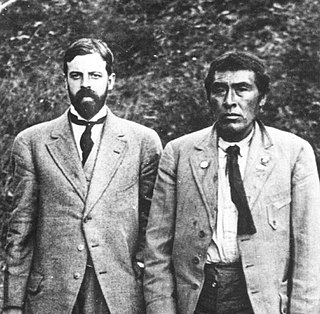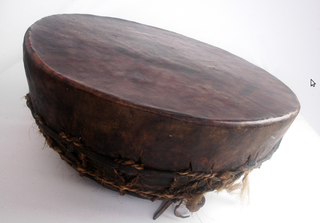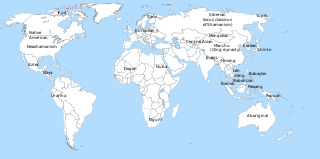
A medicine man or medicine woman is a traditional healer and spiritual leader who serves a community of Indigenous people of the Americas. Individual cultures have their own names, in their respective Indigenous languages, for the spiritual healers and ceremonial leaders in their particular cultures.

Shamanism is a religious practice that involves a practitioner (shaman) interacting with what they believe to be a spirit world through altered states of consciousness, such as trance. The goal of this is usually to direct spirits or spiritual energies into the physical world for the purpose of healing, divination, or to aid human beings in some other way.

Alfred Louis Kroeber was an American cultural anthropologist. He received his PhD under Franz Boas at Columbia University in 1901, the first doctorate in anthropology awarded by Columbia. He was also the first professor appointed to the Department of Anthropology at the University of California, Berkeley. He played an integral role in the early days of its Museum of Anthropology, where he served as director from 1909 through 1947. Kroeber provided detailed information about Ishi, the last surviving member of the Yahi people, whom he studied over a period of years. He was the father of the acclaimed novelist, poet, and writer of short stories Ursula K. Le Guin.

A curandero is a traditional native healer/shaman found in Latin America and the United States. A curandero is claimed to administer shamanistic and spiritistic remedies for mental, emotional, physical and "spiritual" illnesses. Some curanderos, such as Don Pedrito, the Healer of Los Olmos, make use of simple herbs, waters, and even mud to allegedly affect their cures. Others add Catholic elements, such as holy water and pictures of saints. The use of Catholic prayers and other borrowings and lendings is often found alongside native religious elements. Still others, such as Maria Sabina, employ hallucinogenic media. Many curanderos emphasize their native spirituality in healing while being practicing Catholics. None of the practices, claims or methods of curanderos have been validated by the empirical methods of science or medicine and should not be mistaken for objective medical practices.
Neoshamanism refers to new forms of shamanism. It usually means shamanism practiced by Western people as a type of New Age spirituality, without a connection to traditional shamanic societies. It is sometimes also used for modern shamanic rituals and practices which, although they have some connection to the traditional societies in which they originated, have been adapted somehow to modern circumstances. This can include "shamanic" rituals performed as an exhibition, either on stage or for shamanic tourism, as well as modern derivations of traditional systems that incorporate new technology and worldviews.

Yolanda Margarita López was an American painter, printmaker, educator, and film producer. She was known for works focusing on the experiences of Mexican-American women, often challenging the ethnic stereotypes associated with them. Lopez was recognized for her series of paintings which re-imagined the image of the Virgen de Guadalupe. Her work is held in several public collections including the Smithsonian American Art Museum, the San Francisco Museum of Modern Art, and the Los Angeles County Museum of Art.
Alana Kathleen Cordy-Collins was Professor of Anthropology at the University of San Diego. She was an archaeologist whose primary specialization was Peruvian prehistory.
Robert I. Levy was an American psychiatrist and anthropologist known for his fieldwork in Tahiti and Nepal and on the cross-cultural study of emotions. Though he did not receive a formal degree in anthropology, he spent most of his adult life conducting anthropological fieldwork or teaching in departments of anthropology. In developing his approach to anthropology, he credited his cousin, the anthropologist Roy Rappaport, and Gregory Bateson.

The Phoebe A. Hearst Museum of Anthropology is an anthropology museum located in Berkeley, California on the University of California, Berkeley campus.
Entheogenic drugs have been used by various groups for thousands of years. There are numerous historical reports as well as modern, contemporary reports of indigenous groups using entheogens, chemical substances used in a religious, shamanic, or spiritual context.
Mari Lyn Salvador was an American anthropologist, known for her work on Panamanian molas, worn by Kuna women. Her study of these textiles and the people who create them was the foundation for a career in museums that culminated in the directorship at the San Diego Museum of Man and the Hearst Museum of Anthropology. Salvador's career focused on analysis of ethnoaesthetics, or the appreciation of art in its own cultural context, from a variety of peoples.

Michael James Harner was an anthropologist, educator and author. His 1980 book, The Way of the Shaman: a Guide to Power and Healing, has been foundational in the development and popularization of Core Shamanism as a path of personal development for adherents of neoshamanism. He also founded the Foundation for Shamanic Studies.

Cimora is a Peruvian term used to describe a brew with hallucinogenic properties made from the “San Pedro” cacti in South America, used traditionally for shamanic purposes and healing in Peru and Bolivia. The name is also used to describe a number of both hallucinogenic and non-hallucinogenic plants in the region, some of which are used in traditional medicines. Which plants go by the name Cimora is an ethnobotanical problem that has been debated at great length by ethnobotanists in many different journals. The term Cimora is said to refer to “algo malo”, meaning something bad. San Pedro goes by many names including Pachanoi, Aguacolla, El Remedio, Gigantón, and Cactus of the Four Winds. The ritualistic use of the brew is similar to Ayahuasca, which is a South American used as a traditional spirit medicine in Brazil, although while the active ingredient in Ayahuasca is DMT, the active ingredient in Cimora is mescaline. The use of Cimora and the rituals involved have evolved throughout history due to the influence of those who controlled Peru at different stages, although it has almost always involved the use of the San Pedro cactus and its mescaline content.
Vegetalismo is a term used to refer to a practice of mestizo shamanism in the Peruvian Amazon in which the shamans — known as vegetalistas — are said to gain their knowledge and power to cure from the vegetales, or plants of the region. Many believe to receive their knowledge from ingesting the hallucinogenic, emetic brew ayahuasca.

The cultrun is a percussion instrument used by the Mapuche in Chile.
George Francis Carter was an American professor of geography who taught at Johns Hopkins University and later Texas A&M University. Carter had a background in anthropology and conducted archaeological excavations in Southern California. He is best known for supporting the theories of trans-cultural diffusion and early human settlement of the Americas.

Peru has a decentralized healthcare system that consists of a combination of governmental and non-governmental coverage. Five sectors administer healthcare in Peru today: the Ministry of Health, EsSalud, and the Armed Forces (FFAA), National Police (PNP), and the private sector.
James F. O'Connell is Distinguished Professor Emeritus of Anthropology at the University of Utah. He is a member of the National Academy of Sciences of the United States of America and is on the editorial board of the Proceedings of the National Academy of Sciences.

Shamanism is found in many countries around the world, in different regional forms.
Marlene Dobkin de Rios was an American cultural anthropologist, medical anthropologist, and psychotherapist. She conducted fieldwork in the Amazon for almost 30 years. Her research included the use of entheogenic plants by the indigenous peoples of Peru.











